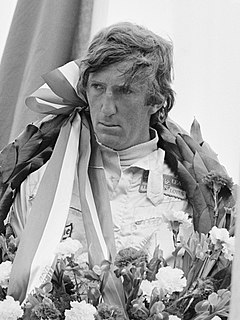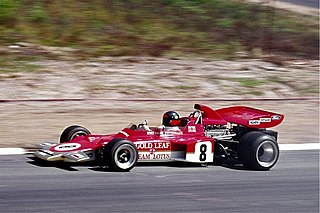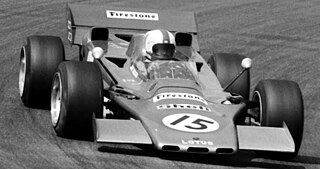
Karl Jochen Rindt was a German-born racing driver who competed with an Austrian license during his career, despite having German and not Austrian citizenship. In 1970, he was killed during practice for the Italian Grand Prix and became the only driver to be posthumously awarded the Formula One World Drivers' Championship.

Anthony Colin Bruce Chapman was an English design engineer, inventor, and builder in the automotive industry, and founder of Lotus Cars.
Harry Ferguson Research Limited was a British company founded by Harry Ferguson who was mostly known as "the father of the modern farm tractor". He was also a pioneer aviator, becoming one of the first to build and fly his own aeroplane in Ireland, and also went on to develop four-wheel drive systems for cars including pioneering their use in Formula One racing cars. The company was based in Siskin Drive, in Coventry, England.

The 1969 Gran Premio de Mexico was a Formula One motor race held at the Ciudad Deportiva Magdalena Mixhuca, Mexico City on October 19, 1969, two weeks after the United States Grand Prix at Watkins Glen. It was race 11 of 11 in both the 1969 World Championship of Drivers and the 1969 International Cup for Formula One Manufacturers. The 65-lap race was won by McLaren driver Denny Hulme after he started from fourth position. Jacky Ickx finished second for the Brabham team and his teammate Jack Brabham came in third.

The 1968 Formula One season was the 22nd season of the FIA's Formula One motor racing. It featured the 19th FIA World Championship, which commenced on 1 January, and ended on 3 November after twelve races, and numerous non-championship races. Graham Hill won the second of his World Championship titles, with Lotus.

The Hon.John Miles was a British racing driver from England. He participated in 15 Formula One World Championship Grands Prix, making his debut on 6 July 1969, in the Lotus 63 4-wheel drive F1 car for which he was the official Team Lotus test driver. He scored a total of 2 championship points with a fifth place in the 1970 South African Grand Prix.
Team Lotus was the motorsport sister company of English sports car manufacturer Lotus Cars. The team ran cars in many motorsport categories including Formula One, Formula Two, Formula Ford, Formula Junior, IndyCar, and sports car racing. More than ten years after its last race, Team Lotus remained one of the most successful racing teams of all time, winning seven Formula One Constructors' titles, six Drivers' Championships, and the Indianapolis 500 in the United States between 1962 and 1978. Under the direction of founder and chief designer Colin Chapman, Lotus was responsible for many innovative and experimental developments in critical motorsport, in both technical and commercial arenas.

The Lotus 48 was a Formula 2 racing car designed by Colin Chapman and Maurice Phillippe and powered by a 1,600 cc (98 cu in) Cosworth FVA engine. It won three races in the hands of Jim Clark but was generally uncompetitive against rival machinery. Ultimately, its main claim to fame is as the car in which Clark was killed at Hockenheim on 7 April 1968.

The Lotus 49 was a Formula One racing car designed by Colin Chapman and Maurice Philippe for the 1967 F1 season. It was designed around the Cosworth DFV engine that would power most of the Formula One grid through the 1970s. It was one of the first F1 cars to use a stressed-member drivetrain to reduce weight, with other teams adopting the concept after its success. It also pioneered the use of aerofoils to generate downforce.

The Lotus 43 was a Formula One racing car designed by Colin Chapman for the 1966 season. Hampered by its heavy and unreliable BRM engine, it won only one race, the 1966 United States Grand Prix.

The Lotus 72 is a Formula One car designed by Colin Chapman and Maurice Philippe of Lotus for the 1970 Formula One season. The 72 was a pioneering design featuring inboard brakes, side-mounted radiators in sidepods, and aerodynamic wings producing down-force.

The Tasman Series was a motor racing competition held annually from 1964 to 1975 over a series of races in New Zealand and Australia. It was named after the Tasman Sea which lies between the two countries. The Tasman Series races were held in January through to late February or early March of each year, during the Formula One off season, taking advantage of winter in the Northern Hemisphere to attract many top drivers to summer in the south. The Tasman Cup was the permanent trophy awarded to the winning driver.

The Lotus 56 was a gas turbine-powered four-wheel-driven racing car, designed by Maurice Philippe as Team Lotus's STP-backed entry in the 1968 Indianapolis 500. All three cars entered retired from the race, Joe Leonard's car expiring while leading just eight laps from the finish.

The Repco Brabham BT24 was a Formula One racing car design. It was one of three cars used by the Brabham racing team during their championship-winning 1967 Formula One season. Only three BT24 chassis were ever raced.
Four-wheel drive (4WD) has only been tried a handful of times in Formula One. In the World Championship era since 1950, only eight such cars are known to have been built.

The Lotus 16 was the second single-seat racing car designed by Colin Chapman, and was built by his Lotus Cars manufacturing company for the Team Lotus racing squad. The Lotus 16 was constructed to compete in both the Formula One and Formula Two categories, and was the first Lotus car to be constructed for Formula One competition. Its design carried over many technological features of the first Lotus single-seater, the Lotus 12, as well as incorporating ideas which Chapman had been developing while working on the Vanwall racing cars. Indeed, such was the visual similarity between the Vanwall and Lotus 16 designs that the Lotus was often dubbed the "mini Vanwall" by the contemporary motor sport press. Although the Lotus 16 only scored five Formula One World Championship points in the three seasons during which it was used, its raw pace pointed the way for its more successful successors, the Lotus 18 and 21.

The Lotus 69 was an open-wheel formula racing car developed by Lotus in 1969 for use in Formula 2, Formula 3, and Formula Ford.
9 Days in Summer is a promotional documentary film made by Ford that tells the story of the development of the Ford-funded Cosworth DFV and Lotus 49, the title coming from the nine Formula One races the car took part in the 1967 Formula One season, which are also extensively featured in the film.

The Repco Brabham BT26 was a Formula One racing car design. A development of the previous BT24, its Repco engines were unreliable, but following a switch to Cosworth DFV engines it scored two World Championship Grand Prix wins and finished runner up in the 1969 World Constructors' Championship.
Mike Pilbeam is a British motorsport designer and engineer known for his work with BRM, Lotus, Surtees and his own company, Pilbeam Racing Designs. An early design was the experimental four wheel drive Formula One BRM P67 of 1964. As of 2014, Pilbeam's company continued to produce hillclimb cars and sports prototype chassis for endurance racing.

















